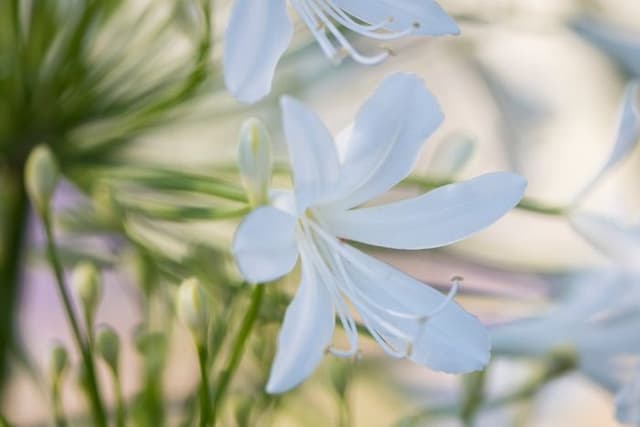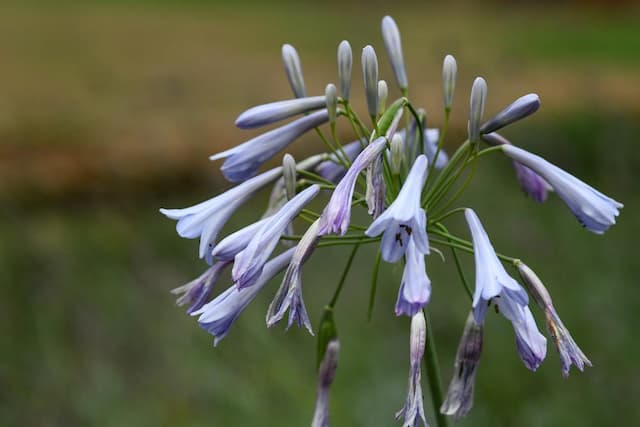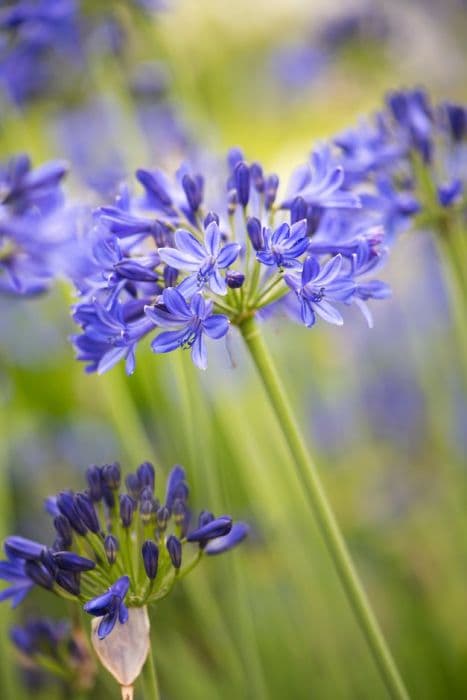African Lily Agapanthus coddii

ABOUT
The plant commonly known as Agapanthus coddii is characterized by lush green foliage that forms a dense clump, from which arise long, slender stalks topped with globular clusters of flowers. The flowers are typically an attractive shade of blue or purple, adding a splash of color to the garden. Each individual flower is trumpet-shaped, contributing to an overall spherical inflorescence that is quite eye-catching. The leaves are strappy and arching, forming a fountain-like appearance around the base of the plant. This particular variety is a favorite in gardens for its striking blooms and foliage, which remain attractive even when the plant is not in flower. The leaves give the plant an ornamental quality throughout the growing season.
About this plant
 Names
NamesFamily
Amaryllidaceae
Synonyms
Codd's African Lily, Codd's Agapanthus
Common names
Agapanthus campanulatus var. coddii, Agapanthus campanulatus subsp. patens.
 Toxicity
ToxicityTo humans
The Agapanthus coddii, commonly known as Agapanthus or African lily, is not highly toxic to humans but can cause some symptoms if ingested. The toxic components are believed to be saponins. If parts of the plant are eaten, they may cause irritation of the gastrointestinal tract. Symptoms of poisoning could include nausea, vomiting, and diarrhea. In general, it is advised to avoid ingesting any part of this plant, and if ingestion does occur, medical attention should be sought, particularly if significant symptoms develop.
To pets
Agapanthus, also known as the African Lily, can be toxic to pets if ingested. The poisonous components, saponins, present in the plant, can cause gastrointestinal issues in animals. Symptoms of poisoning in pets can include vomiting, diarrhea, and nausea. Other signs of distress might also be apparent if your pet has ingested part of an Agapanthus plant. If you suspect your pet has eaten any part of this plant, it is important to contact a veterinarian.
 Characteristics
CharacteristicsLife cycle
Perennials
Foliage type
Evergreen
Color of leaves
Green
Flower color
Blue
Height
2 feet [60 cm]
Spread
2 feet [60 cm]
Plant type
Bulb
Hardiness zones
9
Native area
South Africa
Benefits
 General Benefits
General Benefits- Ornamental Beauty: Agapanthus coddii, commonly known as Agapanthus, adds aesthetic value to gardens with its striking blue or purple flowers.
- Drought Resistance: The plant is well-suited for xeriscaping because it can survive in dry conditions with minimal watering once established.
- Low Maintenance: Agapanthus requires little care beyond occasional watering and feeding, making it ideal for those who want a beautiful garden without a lot of work.
- Soil Erosion Control: With its clumping growth habit and robust root system, Agapanthus can help prevent soil erosion in sloped gardens or areas prone to water run-off.
- Attracts Pollinators: The nectar-rich blooms of Agapanthus attract bees, butterflies, and other beneficial pollinators, supporting biodiversity.
- Long Blooming Season: Agapanthus flowers for a substantial time during the summer months, providing prolonged color and interest in the landscape.
- Versatile Planting Options: It can be planted in borders, pots, or as a focal point in a garden design due to its striking appearance.
- Durable Cut Flowers: The long stems and durable blooms make excellent cut flowers for arrangements and can last for a considerable time in vases.
 Medical Properties
Medical PropertiesThis plant is not used for medical purposes.
 Air-purifying Qualities
Air-purifying QualitiesThis plant is not specifically known for air purifying qualities.
 Other Uses
Other Uses- Agapanthus coddii, commonly known as African lily, can be used for ornamental purposes in gardens and landscapes for its striking blue or purple flowers.
- In floral arrangements, the long-lasting blooms and sturdy stems of African lily make them ideal as cut flowers for bouquets and indoor displays.
- The plant's rhizomes have been used in crafting, where they may be carved or printed onto to create unique patterns and stamps due to their textured surface.
- African lily can be planted for soil erosion control because their root system can help stabilize the ground on slopes and banks.
- As a waterwise plant, African lily can be used in xeriscaping to create environmentally sustainable gardens that require minimal watering.
- The foliage of African lily is sometimes used in art projects or decorations, where the leaves are painted or woven into creative designs.
- Ecologically, African lily provides nectar for pollinators such as bees and butterflies, contributing to the biodiversity of the garden.
- African lily is used as a companion plant because it may help deter certain pests from more susceptible plants with its robust foliage.
- Some cultures use the fibrous leaves of African lily for making ropes or twines, exploiting the natural strength of the plant's fibers.
- During themed events or ceremonies, African lily's vibrant blossoms are used for creating a bold visual impact, particularly in celebrations requiring blue or purple color schemes.
Interesting Facts
 Feng Shui
Feng ShuiThe African Lily is not used in Feng Shui practice.
 Zodiac Sign Compitability
Zodiac Sign CompitabilityThe African Lily is not used in astrology practice.
 Plant Symbolism
Plant Symbolism- Love Letters: Agapanthus, often known as Lily of the Nile or African Lily (although Agapanthus coddii may not be as widely recognized by the same common name), is derived from the Greek words 'agape' meaning love, and 'anthos' meaning flower. Thus, the flowers are often thought to symbolize love letters or messages.
- Beauty: With its striking blue or purple flowers, it's often associated with beauty and elegance, making it a popular choice in gardens and floral arrangements.
- Endurance and Survival: As a plant that is capable of surviving with minimal water and in tough soil conditions, it can also be emblematic of endurance and persistence through difficult circumstances.
- Fertility: The lush and full blooms of the Agapanthus plant are often thought to symbolize fertility and the creation of new life, relating to its use in traditional medicine in some cultures to treat fertility issues.
- Freedom: The way the flowers sway freely on their tall stalks can be interpreted as a symbol of freedom, representing an unbound and unrestrained spirit.
- Home: In some cultures, Agapanthus is planted around homes for protection, symbolizing safety and creating a homely feel.
 Water
WaterLily of the Nile, or Agapanthus coddii, prefers consistent moisture during the growing season. Watering should be done weekly, providing about 1 to 1.5 inches of water each time, which equals approximately 0.6 to 0.9 gallons for an average-sized plant. It's important to water deeply to encourage root growth, so the soil should be soaked thoroughly. During winter or in times of rainfall, reduce watering as the plant requires less moisture. Overwatering or allowing the plant to sit in water can lead to root rot, so ensure good drainage.
 Light
LightLily of the Nile thrives best in full sun to partial shade. They should be placed in a spot where they can receive at least 6 hours of direct sunlight each day. However, in very hot climates, some afternoon shade can be beneficial to prevent scorching. The best lighting condition is bright, indirect light if kept indoors, or a sunny to lightly shaded spot if planted outdoors.
 Temperature
TemperatureLily of the Nile prefers temperatures between 60°F and 80°F, which are ideal for its growth. It can survive in temperatures as low as 50°F, but growth will be slower. In regions where the temperature can dip below 50°F, it's advisable to bring the plant indoors or provide protection. The upper limit for the plant's comfort is around 90°F, beyond which extra care for cooling might be needed.
 Pruning
PruningPruning Lily of the Nile mainly involves deadheading the spent flowers to encourage further blooming and removing any dead or damaged foliage to maintain plant health. It is best to prune after flowering, typically in the late summer or early fall. Pruning once a year is usually sufficient, but you can also remove spent blooms throughout the blooming period.
 Cleaning
CleaningAs needed
 Soil
SoilAgapanthus (commonly known as Lily of the Nile) prefers a well-draining soil mix rich in organic matter. A typical mix can consist of two parts loam, one part peat, and one part perlite or coarse sand to ensure good drainage. The ideal soil pH for Lily of the Nile ranges between 6.0 and 7.0.
 Repotting
RepottingLily of the Nile should be repotted every two to three years or when it becomes root-bound. During the repotting process, choose a container only slightly larger than the previous one to maintain a cozy root environment.
 Humidity & Misting
Humidity & MistingLily of the Nile thrives in average humidity levels. It does not require any special humidity adjustments, making it suitable for typical outdoor conditions where it grows best.
 Suitable locations
Suitable locationsIndoor
Place in bright, indirect light and keep soil moist.
Outdoor
Plant in partial sun; well-draining soil; water regularly.
Hardiness zone
8-10 USDA
 Life cycle
Life cycleThe life cycle of Agapanthus coddii, commonly known as Lily of the Nile, begins with seed germination, where the seeds require a well-drained medium and light for successful sprouting. Following germination, the seedlings grow into juvenile plants, developing roots and foliage as they mature. These plants enter the vegetative stage, in which they produce strappy green leaves in clumps and establish a strong root system. As they reach maturity, Agapanthus coddii begins its reproductive phase, typically in the summer, with tall stalks topped by spherical clusters of blue or white flowers. After blooming, these flowers produce capsule-like fruits that contain seeds, completing the reproductive cycle. The plant then enters a period of dormancy in colder climates or remains evergreen in milder regions, during which it conserves energy for the next growing season.
 Propogation
PropogationPropogation time
Spring-Early Summer
One of the most popular methods to propagate Agapanthus coddii, commonly known as the African lily, is by division of its clumps. This is generally best done in the spring when the plant is emerging from dormancy. To propagate by division, carefully dig up the plant and use a sharp knife or spade to divide the root clump into smaller sections, ensuring that each division has at least one shoot and a portion of the root system. The divisions should then be planted at the same depth they were originally growing at, spaced about 12 inches (approximately 30 centimeters) apart to allow for growth. Water the new divisions thoroughly after planting to help establish them. This method of propagation allows for the quick and reliable production of new plants that are exact clones of the parent, maintaining its desirable traits.







![African lily [Brilliant Blue]](/_next/image?url=https%3A%2F%2Fplants-admin.emdemapps.com%2Fimages%2Fplants%2F%2Fimages%2F604b5e3c28e2b.png&w=640&q=75)

